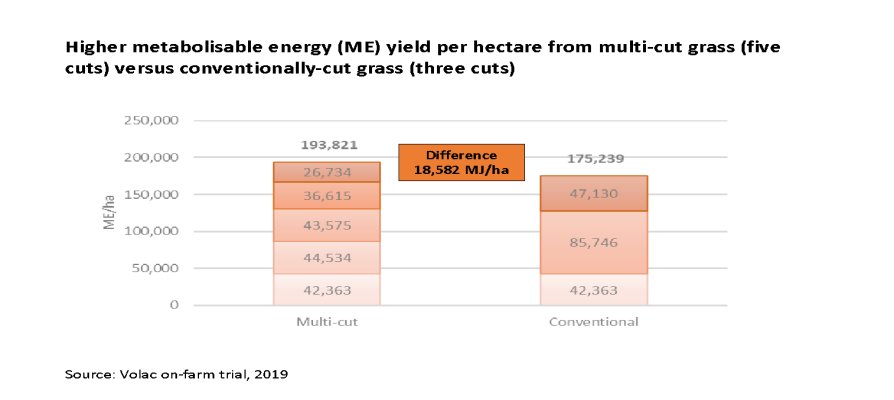Multi-cut grass silage
What are the nutritional benefits of multi-cut grass silage?
With the drive to boost milk from forage, the multi-cut approach of cutting grass for silage younger and taking more cuts per season can produce grass that is both more digestible (and therefore of a higher energy density), and which is higher in crude protein (since the nitrogen assimilated into protein in younger grass has not yet been ‘diluted’ by extra growth). It can also produce a more consistent quality product (and high-yielding dairy cows need consistency).
For herds moving to multi-cut systems, dry matter intakes (DM) can increase by 1.3 kg DM/cow/ day. This can allow around 35-40% more milk production to be targeted from forage.
However, a commonly-asked question is whether multi-cut can match a conventional three-cut system for overall grass yield.
To examine this in more detail, Volac’s team of Ecosyl silage scientists have undertaken research comparing a five-cut system versus a three-cut system in the same field.
First-cuts of both systems were taken on 22 April, and while the DM yields of individual subsequent cuts with the five-cut system were lower than with the three-cut approach, by the end of the season five cuts had yielded an additional 0.92t of DM per hectare.
Moreover, grass from the five-cut system was confirmed to be more nutritious than from the three-cut approach – with an average digestibility 3 D units higher at 72.7, a crude protein content almost 3% higher at 16.7%, and delivering 0.5 MJ/kg more energy.
Based on this combination of extra energy and more overall yield, the five-cut system was calculated to deliver 18,582 MJ/ha more energy over the season than cutting three times. Using a figure of 5.3 MJ of energy being required to produce 1 litre of milk, this equated to it having the potential to deliver 3,506 litres more milk from each hectare over the season.
The fresh grass analysis also revealed that the average crude protein in the multi-cut was almost 3% higher than with three cuts.
Even after deducting the extra contractor costs of cutting more often, the five-cut system was still calculated to be more profitable.
Higher energy yield per hectare in multi-cut versus conventionally-cut grass
 What are the other advantages of multi-cut grass silage?
What are the other advantages of multi-cut grass silage?
As well as nutritional and yield benefit of multi-cut, an advantage of cutting grass more often is that lighter cuts are easier to wilt [LINK THIS TEXT TO EARLIER: ‘WILTING GRASS SILAGE’ PAGE], with faster wilting times reducing in-field respiration losses. Cutting more often also offers more opportunities to apply slurry between cuts – provided appropriate precautions are taken to avoid slurry bacteria contaminating the crop e.g. by injecting slurry. This benefit can be significant if looking to reduce reliance on bagged fertiliser.
Cutting at different times to a conventional two or three-cut approach can also mean better contractor availability – so that grass can be cut closer to its optimum growth stage, rather when the contractor can come to the farm. A multi-cut approach also allows more leeway if there are unavoidable delays to cutting, because younger grass will be further away from heading when its nutritional quality starts to decline.
Cutting grass younger can also reduce its growth stage variability across the field, leading to reduced silage variability in the clamp. Because younger grass contains less stem material, it also tends to be easier to consolidate – which should make control of aerobic spoilage (heating) at feed-out easier.
What % dry matter (DM) should multi-cut grass be wilted to?
The ideal would be around 32% DM. As with conventionally-cut grass, the quicker this can be reached, the better.
The Dutch advocate a much higher %DM (into the 40% DM range), but with the UK having different clamps and wetter, humid weather, this is a mistake as it significantly increases in-field nutritional losses and feed-out losses. By wilting for any longer than 36 hours, more than 4% units of digestibility (0.7 MJ/kg DM ME) can be lost in the field.
With the lower yield per cut from multi-cut grass, the wilting time should be quicker [LINK THIS TEXT TO EARLIER: ‘WILTING GRASS SILAGE’ PAGE]than with heavier crops, which can provide a double benefit for energy content (higher energy at mowing and lower energy losses due to the shorter wilt time).